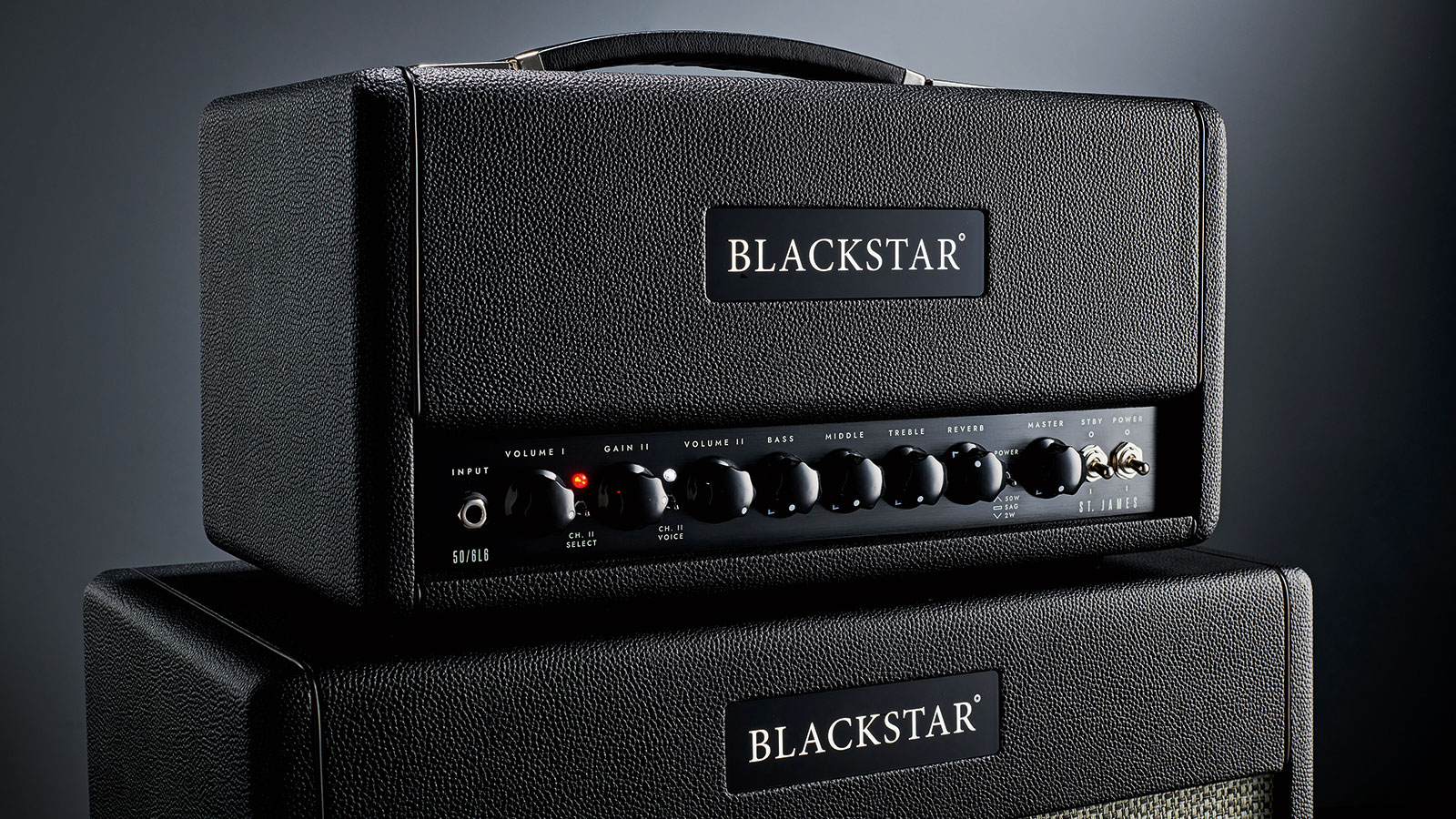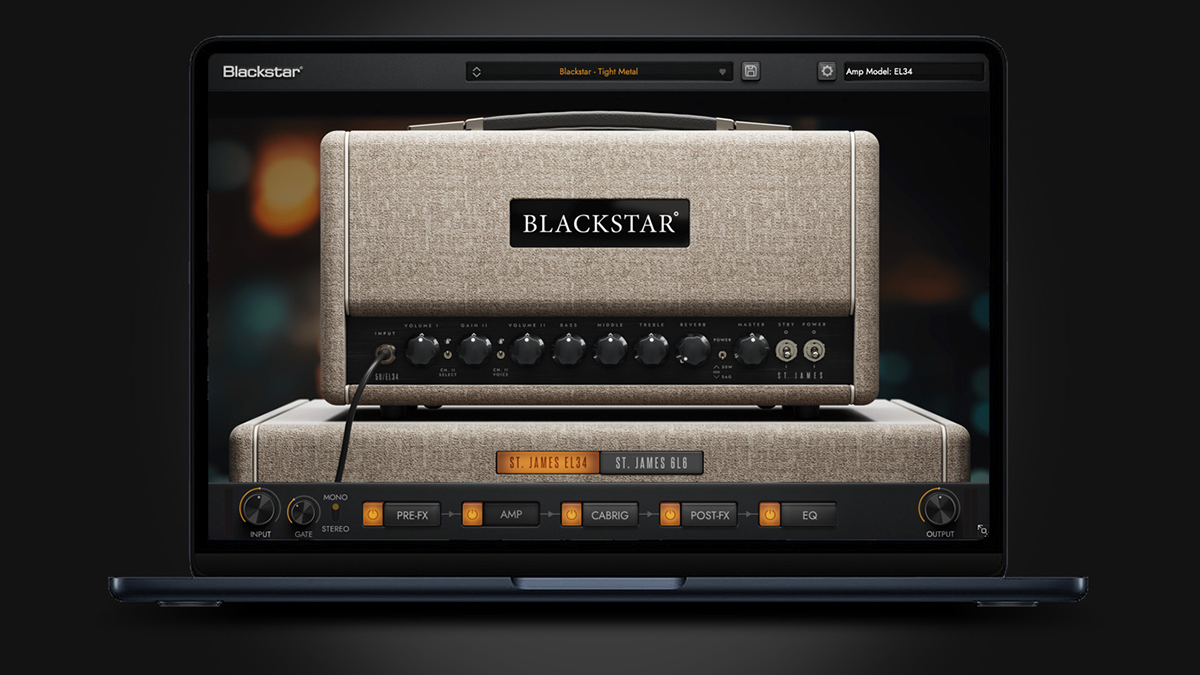
Since being founded 17 years ago in the English town of Northampton, Blackstar has gone on to become one of the most fiercely innovative amplification companies in the music trade.
The company manufactures a whole range of products that cater for just about every need, from the kind of practice units touring musicians use in backstage dressing rooms to high-performance metal machines. You’ll find their logo in living rooms, bedrooms and stages of every kind, and with good reason.
In recent years, the firm has launched the St. James series, which made headlines for being the lightest tube amps ever made, and the 100-watt Amped floor units, which are engineered to replace conventional heads and combos.
These latest developments coincide with the introduction of high-definition IRs in its CabRig software and the plugin versions of the St. James amps in 6L6 and EL34 variants. It’s exactly this kind of thinking that’s placed them at the cutting edge of modern guitar amp design, rewarding modern guitarists with innovation that’s as affordable as it is reliable.
To get an idea of where the company is in 2024 (and what’s coming next), we checked in with Chief Engineer Paul Stevens – who has worked for Peavey, Buddha and Trace Elliot – and Head of Products Alex Gee, the man in charge of all things digital.
Let’s start with the St. James. It has the jaw-dropping tones and wide-ranging connectivity people have grown to expect from Blackstar, but it ditches the traditional transformer for a switched-mode power supply, also featuring a brand new lightweight speaker from Celestion.
Paul Stevens: “Our managing director called me into his office for a discussion about what we could do to shake things up. I said, ‘Tube amps are great but heavy; why don’t we look at lightweight versions?’ His first question was, ‘How?’ I suggested developing a new kind of supply based on switched-mode principles.
We developed lighter-weight speakers with Celestion and also looked at lighter woods, taking weight out where we could
Paul Stevens
“We weren’t the first to do that, but we’ve probably been the first to do it successfully. Tube amp users tend to be resistant to change, but everywhere else in the world we’re seeing these supplies being used for all sorts of things, from phones to televisions. Those products are made in higher quantities; they can afford to develop.
“It wasn’t easy. We had to go through many revisions to get it right – thousands of hours of testing in different temperatures. We then developed lighter-weight speakers with Celestion and also looked at lighter woods, taking weight out where we could.”

It’s interesting how a company that started with the vintage-leaning Artisan models now seems to be focusing on modern needs.
Stevens: “The Artisans will always be there, but we don’t sell big numbers. Modern players are used to connectivity, so that’s the direction we’re going in. People are used to having USB outputs and Bluetooth connectivity.
“It’s not sacrilege. I remember being at Peavey 15 years ago, and we were talking about putting a USB output on something. Some people were like, ‘No way!’ – but now it’s normal. Blackstar is going into all sorts of areas. Earlier on, half of us would be on digital, and everyone else would be amps, but now we’re all working together, combining the technology into everything.
“The DSP gear uses the amps as a reference. The tube amps are incorporating more digital technology, not within the main signal path, but for things like reverb and CabRig. That’s where we’re going – taking amps to where they should be in the 21st century.”
The St. James plugin range is a first for Blackstar. A sign of things to come, perhaps?
Alex Gee: “You could say that. Because we understand why circuitry makes such a difference, we came at the plugins with a unique perspective. It doesn’t matter how we get the sound, as long as we get the sound. The tone is the important thing. Some products have been built in the digital domain first, so we can rapidly prototype the physical.
“We’ve actually been working with plugins for many years. Our digital products like the ID Series and Silverlines were developed in plugin format first and then translated into amps. Although the St. James plugins are our first commercial ones, we’ve been using them internally for a long time.”
There’s some great footage of Jared James Nichols, a dyed-in-the-wool blues purist, being blown away by the quality of the plugin. That was a clever way of promoting it.
Gee: “Jared can make anything sound good. He also knows when to move on. It was stressful going into that first reaction, but he genuinely loved it. Feel is so important to the player. Our St. James plugin reacts like a cranked amp. That’s the barrier we’re trying to remove; you can have the convenience of a plug-in and keep the great sounds you’re used to.”
CabRig and Amped have also been very well-received by guitar players around the world. Why do you think that is?
Gee: “We wanted our CabRig technology to be in all of our products. You have it in our smallest ID:Core, which isn’t much over $100, offering ridiculous value for money. It’s all about creativity, feeling like you’re in a professional studio even if you’re playing over a backing track or writing.
There are other floor amps, but they’re more niche. Ours is a direct replacement. It can hit 100 watts, which is more than anyone needs, but the headroom was important to us
Alex Gee
“The Amped series took a while to develop. There are other floor amps, but they’re more niche. Ours is a direct replacement. It can hit 100 watts, which is more than anyone needs, but the headroom was important to us.
Stevens: “We put the same level of attention into everything. It can be infuriating, because we’ll go round in circles. We’ll listen in different rooms, with different guitars and different players, to get there. It doesn’t matter if it’s an expensive tube amp or a beginner’s solid-state, we put the same amount of attention into everything.”
Who do you see as your biggest competition for the digital end of the market?
Gee: “That’s an interesting question. Neural DSP, Fender and Line 6 are doing brilliant stuff. They’re all good in different ways. We just try to make great products and innovate in different ways to our competitors. I wouldn’t say there’s one that makes us go, ‘Oh, we have to beat those guys!’ It’s not in our nature to think like that.”

What’s coming up next for Blackstar?
Stevens: “When we finished the St. James, it became immediately obvious that the other ranges needed updating. So that’s what I’ve been doing over the past year. We don’t want to become tired or obsolete. I’m also working on things to take the St. James even further. Expect expansion!”
You can’t beat a valve amp live, but the convenience of digital plugins can’t be ignored
Gee: “We’re not going to stop with the Amped series. It was a surprise from Blackstar, and there will be plenty more. The same goes for plugins. That will be an area worth watching because there’s a lot of exciting stuff going on there.
“You can’t beat a valve amp live, but the convenience of digital plugins can’t be ignored. As a valve amp company, we don’t want to ignore that. We’d rather be a product-driven company. We will carry on leading the way on all fronts. We’re not stopping!”
- For more on the brand's current lineup, head over to Blackstar Amplification.







